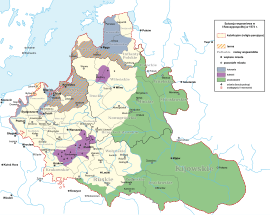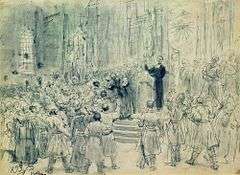Union of Brest

| Part of a series on |
| Eastern Christianity |
|---|
 |
|
Eastern liturgical rites |
|
| Ukrainian Greek Catholic Church |
|---|
| 1585 Union of Brest |
| 1839 Council of Polotsk |
| 1875 Conversion of Chełm Eparchy |
| 1946 Council of Lviv |
| Council for Religious Affairs |
| Anti-Catholicism in the Soviet Union |
| Eastern Catholic victims of Soviet persecutions |
The Union of Brest, or Union of Brześć, was the 1595-96 decision of the Ruthenian Orthodox Church eparchies (dioceses) in the Polish-Lithuanian Commonwealth to break relations with the Eastern Orthodox Church and to enter into communion with, and place itself under the authority of the Pope of Rome. The Eparchy of Mukachevo that was located in the Kingdom of Hungary was left out of the process.
The union
Prior attempts to come to union with Catholic church were made on several occasions, including an instance in which the Metropolitan of Kiev Isidore signed the Union of Florence and technically united the Ruthenian Orthodox Church.
In 1588-1589 Patriarch of Constantinople Jeremias II traveled across the Eastern Europe, particularly the Polish-Lithuanian Commonwealth and the Grand Duchy of Moscow, where he finally since 1458 acknowledged the Russian Orthodox Church in Moscow and consecrated Patriarch Job of Moscow (previously held by Isidore of Kiev). Patriarch Jeremias II deposed the Metropolitan of Kiev Onesiphorus Divochka and on approval of the King of Poland Sigismund III consecrated Michael Rohoza as the new Metropolitan of Kiev, Halych, and all Rus'.[1]
After leaving of Jeremias II,[1] in 1590 four out of nine bishops of the Ruthenian Orthodox Church (Vilnius) gathered in synod in the city of Brest and signed a declaration of their readiness to sign the union with Rome[1] composed 33 articles of Union, which were accepted by the Pope of Rome. At first widely successful, within several decades it had lost much of its initial support,[2] mainly due to its enforcement on the Orthodox parishes, which stirred several massive uprisings.
- List of bishops who in 1590 signed the declaration of intent[1]
- Bishop of Luck and Ostrog Kyrylo Terletskyi (exarch of Ecumenical Patriarch of Constantinople)[1]
- Bishop of Pinsk and Turow Leontiy Pelchytskyi
- Bishop of Chelm Dionisiy Zbyruiskyi
- Bishop of Lwow Hedeon Balaban
- List of bishops who later joined the agreement
- Bishop of Przemysl Mykhailo Kopystenskyi
- Archbishop of Polock Herman Zahorksyi (acting)
- Bishop of Wlodzimierz and Bresc Ipatiy Potiy[1]
- Metropolitan of Kijow, Halicz and all Rus Mykhailo Rohoza (seated in Vilnius)[1]
On request of Konstanty Wasyl Ostrogski, Hypatius Pociej left his post of Greater Castellan of Brześć Litewski and accepted from the King appointment to the Wlodzimierz eparchy.[1] Prince Konstanty Wasyl Ostrogski considered that Metropolitan of Kijow should reach an agreement with eastern patriarchs, the Patriarch of Moscow, and Moldavian Orthodox Church for joint participation in agreement with the Latin Church.[1]
In 1595 both Hedeon Balaban and Mykhailo Kopystenskyi withdrew their signatures from the agreement.[1] The same year Archbishop of Polotsk Nathaniel Sielitskyi has died and was replaced with Herman Zahorksyi.
The union was solemnly and publicly proclaimed in the Hall of Constantine in the Vatican. Canon Eustachy Wołłowicz, of Vilnius, read in Ruthenian and Latin the letter of the Ruthenian episcopate to the Pope, dated 12 June 1595. Cardinal Silvio Antoniani thanked the Ruthenian episcopate in the name of the Pope, and expressed his joy at the happy event. Then Hipacy Pociej, Bishop of Volodymyr, in his own name and that of the Ruthenian episcopate, read in Latin the formula of abjuration of the Greek Schism, Bishop Cyril Terlecki of Lutsk read it in Ruthenian, and they affixed their signatures. Pope Clement VIII then addressed to them an allocution, expressing his joy and promising the Ruthenians his support. A medal was struck to commemorate the event, with the inscription: Ruthenis receptis. On the same day the bull Magnus Dominus et laudabilis nimis was published,[3] announcing to the Roman Catholic world the first time Ruthenians were in the unity of the Roman Church. The bull recites the events which led to the union, the arrival of Pociej and Terlecki at Rome, their abjuration, and the concession to the Ruthenians that they should retain their own rite, saving such customs as were opposed to the purity of Catholic doctrine and incompatible with the communion of the Roman Church. On 7 February 1596, Pope Clement VIII addressed to the Ruthenian episcopate the brief Benedictus sit Pastor ille bonus, enjoining the convocation of a synod in which the Ruthenian bishops were to recite the profession of the Catholic Faith. Various letters were also sent to the Polish king, princes, and magnates exhorting them to receive the Ruthenians under their protection. Another bull, Decet Romanum pontificem, dated 23 February 1596, defined the rights of the Ruthenian episcopate and their relations in subjection to the Holy See.[4]
It was agreed that the filioque should not be inserted in the Nicene Creed, and that the Ruthenians "should remain with that which was handed down to us in the Holy Scriptures, in the Gospel, and in the writings of the holy Greek Doctors, that is, that the Holy Spirit proceeds, not from two sources and not by a double procession, but from one origin, from the Father through the Son."[lower-alpha 1] The bishops asked to be dispensed from the obligation of introducing the Gregorian Calendar, so as to avoid popular discontent and dissensions, and insisted that the king should grant them, as of right, the dignity of senators.[4]

The union was strongly supported by the King of Poland and Grand Duke of Lithuania, Sigismund III Vasa, but opposed by some bishops and prominent nobles of Rus, and perhaps most importantly, by the nascent Cossack movement for Ukrainian self-rule. The result was "Rus fighting against Rus," and the splitting of the Church of Rus into Greek Catholic and Greek Orthodox jurisdictions.
See also
- Josaphat Kuntsevych
- Ukrainian Greek Catholic Church
- Belarusian Greek Catholic Church
- Ruthenian Catholic Church
- Union of Uzhhorod
- History of Christianity in Ukraine
- Jeremi Wiśniowiecki
- Eastern Orthodox – Roman Catholic theological differences
- Eastern Orthodox – Roman Catholic ecclesiastical differences
Notes
- ↑ See the 1575 Profession of faith prescribed for the Greeks.[5](nn. 1303, 1307, 1863–1870, 1985–1987)
- ↑ In 1893, Russian painter Ilya Repin "depicted the moment when a Jesuit monk encourages residents of Vitebsk join the union," in a drawing on the theme of "preaching Kuntsevych".[6]
References
- 1 2 3 4 5 6 7 8 9 10 Hudziak, B.O., Tu, O.Yu. The 1596 Brest Church Union (БЕРЕСТЕЙСЬКА ЦЕРКОВНА УНІЯ 1596). Encyclopedia of History of Ukraine.
- ↑ Dvornik, Francis (1962). The Slavs in European history and civilization (3rd. pbk. ed.). New Brunswick [u.a.]: Rutgers University Press. ISBN 9780813507996.
- ↑ Pope Clement VIII (1753) [promulgated 1595-12-23]. "Unio Nationis Ruthenae cum Ecclesia Romana". In Cocquelines, Charles. Bullarum diplomatum et privilegiorum sanctorum Romanorum pontificum (in Latin). T.5 pt.2. Rome: Hieronymi Mainardi. pp. 87–92. OCLC 754549972.
- 1 2

- ↑ Denzinger, Heinrich; Hünermann, Peter; et al., eds. (2012). Enchiridion symbolorum: a compendium of creeds, definitions and declarations of the Catholic Church (43rd ed.). San Francisco: Ignatius Press. ISBN 0898707463.
- ↑ Brodskiĭ, Iosif; Moskvinov, V. N., eds. (1969). Новое о Репине : статьи и письма художника. Воспоминания учеников и друзей. Публикации (in Russian). Leningrad: Художник РСФСР. p. 389. OCLC 4599550.
[...] 1893 года на тему 'Проповедь Кунцевича', посвященных одному из героических эпизодов в жизни белорусского народа. Художник изобразил момент, когда монах-иезуит призывает жителей Витебска примкнуть к унии, [...]
Further reading
- Magocsi, Paul R.; Pop, Ivan, eds. (2005). Encyclopedia of Rusyn history and culture. Toronto: University of Toronto Press. ISBN 0-8020-3566-3.
- Pekar, Athanasius (1992). "The Union of Brest and attempts to destroy it". Analecta Ordinis S. Basilii Magni. Romae: Sumptibus PP. Basilianorum. 20: 152–170. Archived from the original on 2011-01-07.
- Senyk, Sophia (1996). "The background of the Union of Brest. part 1". Analecta Ordinis S. Basilii Magni. Romae: Sumptibus PP. Basilianorum. 21: 103–144. Archived from the original on 2007-07-01. "The background of the Union of Brest. part 2". Archived from the original on 2011-01-07.
External links
- "Ukrainian Greek Catholic Church". Religious Information Service of Ukraine. Lviv: Institute of Religion and Society of the Ukrainian Catholic University. 2011-08-15. Archived from the original on 2013-03-20.
- The text
- FAMILY TREES of priests of the Byzantine-rite church in SLOVAKIA 1650-2006
- At the Service of Church Unity